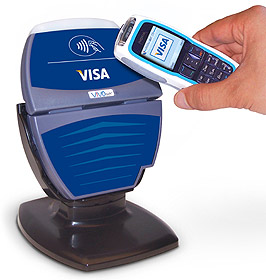By Lou Covey, Editorial DirectorFootwasher Media
The inaugural Mobile Commerce World (#mobilecw) wrapped up last week after presenting a very different view of the future of retail business. The economic barriers to entry for business are rapidly coming down as mobile commerce technology expands, but choosing the right approach is difficult in a highly fractured market.
Online shopping has enjoyed phenomenal growth at the expense of local business, so the "big deal" at the conference were apps that give back some of the power to brick and mortar retail. There was no lack of companies presenting "the" answer for these merchants, nor that for encouragement of adoption of new technology from the panel and "executive armchair" sessions.
 There were, however, some words of warning.
There were, however, some words of warning.
Bill Gajda, head of Visa's Global Market Products, stated almost offhandedly that QR codes are dead when it comes to commerce. That was bad news for m-commerce app providers who are expecting the retail world to add the codes or replace barcodes on limited packaging space. The codes may have a small place in promotion and for downloading apps and sharing contact information, but for buying and selling they are not a viable option.
In-store apps that allow customers to find coupons, research products and even purchase products from their phone without standing in line. The Apple Store approach of having sales associates with handheld devices for purchases was mentioned often during the day. Apps that have a greater chance for success are those that incorporate barcodes into their scanning technology as the codes are already ubiquitous for inventory tracking. Shoppinpal.com is an example of that approach (see video interview here), allowing shoppers to scan a product barcode to get additional product information and choose the purchase the product at that moment, or put it on a list for future consideration. It also alerts a store manager via email that someone is looking at a particular product. This gives the manager the opportunity to find the customer in the store, answer any questions the customer might have and establish a relationship with the customer... rather than intruding on someone who is "just looking."
The major trend in m-commerce is near-field communications (NFC) and the United States is lagging in adoption for developed countries, and could even be considered "third world" based on the level of adoption, according to Gajda. No iPhones, Android phones version 2.3 and older, Windows Mango, low-cost Blackberry phones and most Japanese-made phones available in the US have NFC capabilities. Further, stores using NFC are split between Pay Pass enabled, Google Wallet enabled stores and Starbucks stores that have teamed with Square. That means only the geekiest consumers among us are using the technology. And then we have the banking industry.
The Yankee Group estimated mobile transfer payments were more than $617 billion world wide and would grow to more than $1 Trillion by 2016. However, according to Dwolla founder Ben Milne, speaking at an executive round table at Mobile Commerce World on the state of mobile wallets, just the revenue banks handle for wire transfers totaled more than $30 trillion (that is not a typo). Let's be clear here: that's 10 times the US national debt every year. If they skim just 1 percent of that it $30 billion. The banks are not ready to give up that revenue stream, according to Milne, and are putting extreme pressure on governments worldwide to keep control of that from the highly fragmented mobile payments industry.
Mobile commerce is very much in its infancy. It has taken steps to ensure security (it is currently more secure than credit cards) and is helping raise living standards in the third world. If faces significant hurdles in the developed world, mostly in the United States, but he future does does look encouraging.
